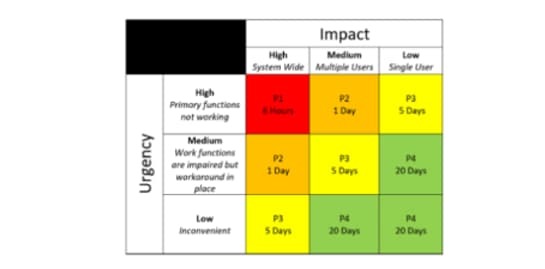In many organizations, the notion of streamlining IT service management seems to rest on a simple idea: use a single field to drive multiple functions. It might seem efficient to link Service Level Agreements (SLAs) directly to the incident priority field. However, practice shows that this approach oversimplifies incident management, introduces inflexibility, and—critically—removes the nuanced control that frontline teams need to manage incidents effectively. In some ITSM implementations, teams don’t even have the ability to adjust priorities manually, which means that one misclassified field value can set off a chain reaction of misaligned expectations and service failures.
ITIL® Definition:
Prioritisation:
An action of selecting tasks to work on first when it is impossible to assign resources to all tasks in the backlog.
Task priority:
The importance of a task relative to other tasks. Tasks with a higher priority should be worked on first. Priority is defined in the context of all the tasks in a backlog.
Examples from Policies where Priority is linked to SLA

1. The Over-Simplification of Incident Complexity
Incident management is inherently multi-dimensional. While the priority may capture a snapshot of urgency or impact, it only scratches the surface. There are other key factors to consider:
Customer Tier and Contractual Obligations: Different customers often have unique SLA requirements based on their service agreements.
Business Impact and Operational Context: An incident labeled as high priority might affect one part of the organization more severely than another.
By linking SLAs solely to the priority field, you reduce a complex scenario to a single attribute. This can result in overly generic rules that don’t truly reflect the nature of the incident.
2. Limited Flexibility and the Inability to Adapt
When SLAs are mechanically tied to priority, you lose much-needed flexibility:
Dynamic Nature of Incidents: As more information becomes available, incidents might need to be reclassified. However, if changes to the priority field automatically trigger a different SLA, you can end up with confusing or conflicting expectations.
Immutable Priority Assignment: In many ITSM tools, incident priority isn’t something the resolution teams can manipulate on the fly. If the tool or process doesn’t allow for manual prioritization, teams are forced to work within a rigid framework that might not match the evolving situation.
This restriction means that if an incident starts as a lower priority due to misclassification or lack of detailed context, the team might not have the authority to re-prioritize it—even if the business impact escalates. The inability to adjust priorities further solidifies the misalignment between the incident’s actual nature and the SLA triggered by its predetermined category.
3. Inconsistent SLA Application and Audit Challenges
When an SLA is strictly tied to the priority field:
Misclassification Risks: Any error in classification directly impacts the SLA. For example, a P2 incident might require a swift resolution in one context but could be overlooked if the tool automates a lower urgency SLA based only on the priority score.
Confusing Audit Trails: If an incident’s priority shifts during its lifecycle, the automatically reassigned SLA may create records that are inconsistent or difficult to audit. This can complicate post-incident analyses and hinder continuous improvement efforts.
4. Overloading a Single Field: The Core Issue
The priority field is designed to give a high-level view of urgency. Assigning it the additional role of dictating exact SLA time frames forces too much responsibility onto one variable. This often results in:
Maintenance Challenges: The one-size-fits-all approach becomes hard to maintain, particularly as service demands evolve.
Error Propagation: A single misstep in priority assignment cascades into poor customer service and internal frustration.
5. Illustrating the Problem: A Multi-Dimensional SLA Decision Process
A better approach is to acknowledge that an effective SLA system needs to aggregate multiple data points. Consider this visual breakdown:

In this model, SLA determination isn’t confined to a single attribute but rather emerges from a robust intersection of factors—ensuring that the nuances of each incident are fully captured.
6. Alternate Strategies for a Nuanced Approach
Rather than relying solely on priority-driven SLA assignments, consider a multi-dimensional strategy:
Enhanced Data Fields: Incorporate additional attributes such as incident type, affected system, customer segment, and contractual details.
Rules-Based Engine: Use a flexible engine or decision tree that aggregates various inputs instead of triggering actions off a single field.
Empowering Teams: Adjust your ITSM workflow to allow incident teams the authority to re-prioritize issues. This human element can bridge the gap when automated systems miss contextual subtleties.
Such practices ensure that your SLA targets more accurately reflect real-world business needs—and empower teams to drive better service quality.
Conclusion
Linking SLAs strictly to the priority field might appear to simplify the ITSM configuration, but it actually sets up your service management process for rigid responses and unintended oversights. This issue is compounded when teams using the ITSM tool lack the capability to manually adjust incident priorities. The result is a counterproductive setup where misclassification can lead to unmet SLAs, poor customer satisfaction, and challenges during post-incident reviews.
By adopting a more multi-dimensional and flexible approach, organizations can better meet diverse customer needs, embrace dynamic incident complexities, and ultimately drive superior service outcomes.
Have you ever felt the frustration of knowing an incident needed urgent attention, but couldn’t change its priority because it would set off a P1 KPI? How did you navigate that challenge while ensuring the incident's criticality was still acknowledged?
